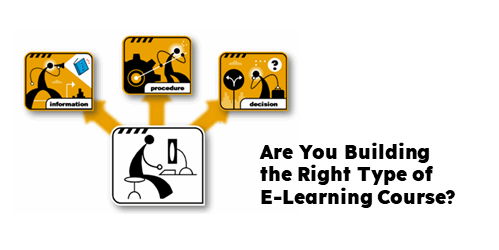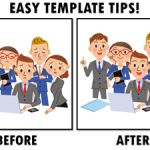
Building an e-learning course can be time-consuming and costly. Because of this you don’t want to waste your resources by making your e-learning course more complex than it needs to be. Instead, your objective is to create the best e-learning course you can with the limited resources you have.
Identify the Course’s Purpose
The intent of most e-learning courses is to change performance. However, the type of course that’s usually built focuses on sharing information rather than performance improvements. This happens because most people focus on delivering content rather than on changing performance.
Your first step is to get your client focused on the real performance goals and then guide them to the right type of intervention. Sometimes it means they don’t need an e-learning course. In that case you save time and money by not building the e-learning course.
However, if they still need (or want) an e-learning course, then determine what type of course they need. By identifying the type of course you are building, it’s easier to determine what resources you can commit.
Understand the Type of Course

E-learning courses typically focus one of two things: sharing information or changing performance. And, within that framework, there are basically three types of e-learning courses.
- Communicate information with no performance expectations. Information-based courses communicate new information but have no built-in expectations of changed performance. A good example is a course that highlights new features of a software application. You learn about the new the features but you aren’t required to do anything with this new information.
- Give step-by-step instructions that have specific outcomes. These courses are focused on procedures and how to do something. They’re made up of repeatable tasks that are very close to what the learner will do at work. A good example is showing someone how to complete a worksheet or use software.
- Share guidelines to help the learner solve problems. The most challenging courses to design are those where you teach principles or guidelines versus repeatable steps. You really have to understand the nuances of the learner’s situation and how the principles can be applied while respecting the fact that each application is somewhat unique.
All three types of courses can be as simple or complex in design as you want to make them. Keep in mind that the more complex the course is, the more time and effort it will take to build it.
Your best bet is to minimize the complexity and free your resources for the projects that are going to make the most impact.
To build good e-learning courses means that you have to know what type of course you’re building and get the most out of your resources. Learn to differentiate between information and performance based courses. Then move your resources to those courses that are going to have the most impact.
Events
Free E-Learning Resources

















0
comments